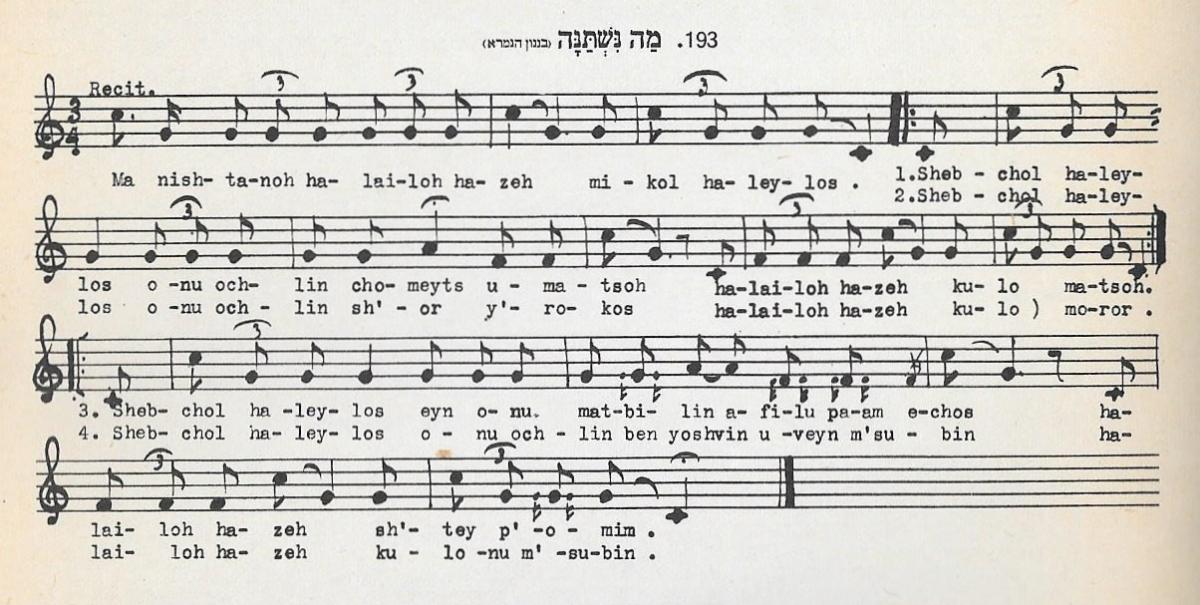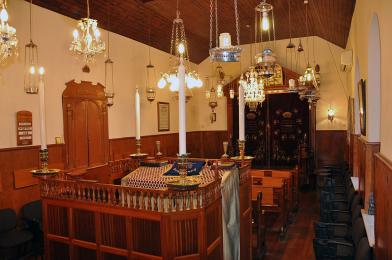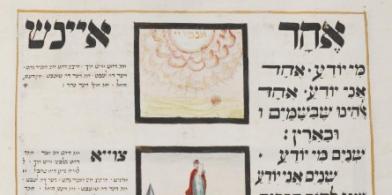- Di Zahav (excerpt)
Four Melodies for Four Questions
New Findings about the 'Traditional' Israeli Melody for Mah Nishtanah
Jewish music research rarely considers the Jewish home as a performing stage, even though major ceremonies of Judaism which include music take place within the circle of the immediate or extended family. The Passover seder (lit. “order”) is one of the main home rituals. The Haggadah, the order of texts recounting the Exodus from Egypt, is read before and after the seder meal. This text combines elements of a learning session (casuistry of Oral Law passages and other pedagogical texts) with liturgical ones (blessings, prayers and psalms).
The musical repertoire for the performance of the Haggadah’s texts grew exponentially through time (see for example our Song of the Month archive). The singing of serial folksongs added at the end of the seder is a late medieval European innovation that probably enhanced the process of the Haggadah’s musicalization. These additions also blurred the borderline between the religious and mundane spheres in this domestic Jewish ritual.
The music for different sections of the Haggadah has been maintained and transmitted by oral tradition as well as in written sources since the mid-19th century and, in the 20th century, through recordings. A very accomplished piece of research on the subject is Ruth Sragow Newhouse’s dissertation, The Music of the Passover Seder from Notated Sources (1644-1945) (University of Maryland, 1980.) We have benefitted from her work in the writing of this Song of the Month while expanding her findings in totally new directions.
As a rule, through the ages the Haggadah was performed with diverse techniques of recitation and learning tunes, fitting the character of the texts included in this compilation. As modernity made its inroads into Jewish homes, more metric tunes (such as Hassidic melodies) took over texts of the Haggadah that were performed beforehand using traditional unmetered study or prayer formulae. A canon of tunes developed, first through the printing of musical notations as appendices to Haggadot, and later through the dissemination of commercial recordings and learning kits, many of them produced in Israel.
The subject of this article is the singing of the section known as the Four Questions (Heb. ‘Arba’ kushiyot; see’ Sragow Newhouse, vol. I, pp. 92-93 and vol. II, pp. 143-153). This pedagogical text is certainly among the oldest strata of the Haggadah. The questions appear almost literary as we know them today in the oldest stratum of the Talmud (BT Pesahim 10, 116a), with the exception of the third question that still recalls the Temple sacrifices.
We learned: They poured for him the second cup, and here the son asks his father. And if the son does not have the knowledge [to ask questions of his own], his father teaches him. Why is this night different from all other nights? As on all other nights we eat leavened bread and matza; on this night all matza. As on all other nights we eat other vegetables; on this night bitter herbs. As on all other nights we eat roasted, stewed, cooked meat, on this night all roasted As on all other nights we dip [vegetables in a liquid] once; on this night, twice.
The traditional Ashkenazi learning tune
Already in the late Middle Ages Rabbi Jacob ben Moses ha-Levi Moellin (1360?–1427; referred to as Maharil) wrote that this text should be sung with a pleasant tune (niggun yafeh; see, Sefer Maharil, Jerusalem 1978, Hilkhot seder Pessah, fol. 15a). This remark by the most authoritative source on the Ashkenazi musical minhag (custom) singles out the Four Questions as a particularly musical moment in the seder.
Until the mid-20th century, most Ashkenazi Jews intoned this text with a pentatonic learning tune without clear beat and meter. This tune is variously called the Gemara (Talmud), Mishnah, Lern or Stubentrop nign. Thirty out of the thirty-two notated versions in the corpus investigated by Sragow Newhouse follow this pattern, thus attesting to this deep-rooted musical practice.
A child traditionally recited these Four Questions solo, in a responsorial manner, with the family acting as a choir performing the answers to the questions. In some Ashkenazi communities, a paraphrase in Yiddish followed the Hebrew text phrase by phrase, a common learning technique in religious schools in Eastern Europe. Our website includes two illuminating performances of the Four Questions using this tune sung by Prof. Eliyahu Schleifer, below.
Ma Nishtana Old Nusach:
Ma Nishtana Old Nusach with Yiddish:
This traditional tune was transcribed, in many variants, in several sources that can be grouped into two versions, one in major mode (the vast majority of the documented versions) and one in a minor mode. Both versions are pentatonic or even tetratonic and are characterized by a predominant recitation tone that is preceded or followed by intervallic leaps of fourths and fifths in both directions.
Among the earliest notated versions of the learning tune in its common major version is found in Abraham Baer’s Ba’al Tefillah (below) first published in c. 1877 (no. 764). The note G (5) is the recitation tone, except for the third question in which c (8) takes the reciting role, creating the musical peak of the whole piece. C (1) marks the ending cadence and F (4) serves as the preparation of the end. Unique to this version is the ending on 5 rather than 1. It also appeared shortly after in the important collection of music for the Haggadah by Adolph Schönfeld (cantor in Posen), Recitative und Gesänge Lob und Danklieder: Zum Vortrage Am Erster und Zweiten Abende Des Ueberschreitungsfestes. (Posen: Im Selbstverlage des Verfassers, 1884, no. 4). Schönfeld’s version, defined as “gemara niggun,” is similar to Baer’s except for the use of additional passing tones, 2, 7flat and 7 that hints to a more Eastern European character.

Baer Ma Nishtana, 1877
Close variants of Baer’s and Schönfeld’s tune (except for the final cadence in 1 rather than 5) were published in the USA in the first two decades of the 20th century. Two notable publications containing the melody are Israel Goldfarb and Samuel E. Goldfarb, The Jewish Songster: Music for Voice and Piano (Brooklyn: Religious Schools of Congregation Beth Israel, 1925) and Abraham W. Binder, Seder Melodies: The Hagaddah Set to Music: in Hebrew and English for the Religious School, Congregational Seder, and Home Services (New York: Bloch Pub. Co, 1925). In Europe during the early 20th century, we should mention the presence of this melody in the exceptionally popular A. M. Silbermann and Erwin Singer, Die Haggadah Des Kindes (Berlin: Menorah, 1933), which has been published since then in at least eight editions in several different languages.
Goldfarb’s version was reproduced in the influential work by the head of the Jewish music education board of Chicago, Harry Coopersmith, Songs of My People (Chicago: The Anshe Emet synagogue, 1937). In spite of Coopersmith’s notation with a fixed meter, it is clear that the performance was intended to be in the recitative style. Moshe Nathanson also reproduced a variant of the same tune (below) in his important songster Manginot shirenu: Hebrew melodies old and new, religious and secular (New York: Hebrew Publishing House, 1939). Nathanson qualifies the tune, as Schönfeld does, as “niggun gemara.” The same tune also entered the New Haggadah of the Reconstructionist movement, edited by Mordecai Kaplan (1941). Judith Kaplan Eisenstein, along with along with Ira Eisenstein and Eugene Kohn, authored and selected the music for this Haggadah. The tune, which she included in her Gateway to Jewish Song (New York 1939), was most probably shared with Nathanson’s publication, for he was the cantor at the Reconstructionist synagogue which Eisenstein’s father founded in New York City.

Nathanson, 1939
In contrast to this German-oriented lineage of the learning tune, Abraham Z. Idelsohn brings in vol. 8, of his Thesaurus, a version (no. 117; see also discussion of the tune in p. xvii) in minor mode (below). The tune is based on the descending triad 8-5 (recitation tone)-1 with the addition use of 3. This minor version may reflect an Eastern European version of this ancient learning formula.

Idelsohn, 1932
Alternative Ashkenazi tunes
Not all Ashkenazi homes, at least by the early 20th century, followed the traditional “gemara niggun” in the performance of the Four Questions. Leon Kornitzer in his Jüdische Klänge (Hamburg: M. Lessmann, 1933) published an old niggun from West Prussia transmitted to him by K. Lowenstein. Although this tune also recalls the Ashkenazi learning chant, its metric character and the contour of the melody in the minor key provide a distinctive aesthetic quality to it. This tune (and others) point to a tradition of metered tunes for the Four Questions that challenged the traditional chant. The following case follows naturally this statement.
Non-Ashkenazi tunes
The “Israeli” tune was also adopted by the homes of immigrants from the Land of Islam in Israel, launching a new tradition there as well. In their process of socialization into the Ashkenazi dominated milieu, Sephardic and Oriental Jews learned many metric Haggadah tunes taught in kindergartens, schools and even in the army. Until immigration to Israel, in the non-Ashkenazi Jewish traditions, as in the Ashkenazi ones, the Four Questions (as most of the Haggadah) were recited with simple melodic formulae of very narrow range, characteristic of learning and praying tunes rather than well-defined metric melodies.
An example of such non-Ashkenazi recitations of the Four Questions can be found in Rahel Musleah, (Songs of the Jews of Calcutta. Cedarhust, N.Y.: Tara Publications, 1991), reflecting the tradition of Calcutta (Kolkata), whose Jewish community traces its origins to Baghdadi Jewry. Sephardic melodies of this kind are also found in Abraham Z. Idelsohn, Thesaurus, vol. 4, no. 79, and Isaac Levy, Antologia de la liturgia judeo-española, vol. 3, no. 203. A wonderful version of the Four Questions in Judeo-Spanish from Turkey sung by Eliyahu Bonomo (below) exemplifies this type of non-Ashkenazi tunes (NLI, N SA, Y 6812 [originally recorded by Renanot – Institute of Jewish Music]).
Ma Nishtana in Ladino, Eliyahu Bonomo:
The “Israeli” tune
By the mid-20th century newly composed tunes in Israel slowly substituted the traditional chanting of several sections of the Haggadah, the Four Questions included. These new tunes, composed in the spirit of the new Hebrew musical culture, had a lively metric character calling for congregational singing rathan than by the leader of the seder. Several of these tunes (which as a rule are not discussed in Sragow Newhouse’s dissertation) were created for innovative celebrations of the seder in kibbutzim. Of course, such an approach had antecedents in Europe, as we have seen in the case of Kornitzer, as well as in Hassidic circles.
One of the most celebrated and widespread of these new Israeli tunes is the one for the Four Questions that emanates not from a kibbutz but rather from an urban setting, the “Oratorium le-hag ha-herut” (Oratorio for the Holiday of Freedom) by Ephraim Nieświżski/Niswiszki, renamed Ephraim Abileah (1881-1953). A Russian-born Jewish immigrant in Palestine, Abileah was a founding member of the Saint Petersburg Society for Jewish Folk Music. His work was performed only once in Haifa in 1936, but his tune for the Four Questions became viral, especially after it was published in songsters distributed in Israel and the diaspora and recorded and broadcast by the Israeli Radio.
Our colleague Prof. Eliyahu Schleifer publicized the origins of this tune in Abileah’s work some time ago and the story was reproduced online by Akiva Zimmermann, as well as by Cantor Alame Simons Katzew on the website of the Reform movement, all stemming from Schleifer’s teaching. It was also common knowledge that the melody was published with musical notation posthumously in 1956, in a special publication celebrating the seventieth birthday of Miriam Abileah, Ephraims’ wife, in an arrangement for piano and voice (Haifa: Universum le-musiqa Abileah, 1956, copy in NLI, 224 N 2012).
Surprisingly, until now no one had consulted the original score by Abileah, found in his archive at the Department of Music of the National Library of Israel, catalogued as Mus. 190 E 15 (1). The title of the manuscript reads:
אורטוריום לחג החרות בעד תזמורת סמפונית, מקהלה מעורבת וסולו מאת אפרים אבילאה, מנהל הסטודיו למוסיקה מקורית א'י בחיפה, רח' מכלס, בית נדדי, חלק ראשון א'.
In addition to the score, a complete recording of the oratorio performed by a solo cantor with piano reduction is available as well. Cantor Ephraim Di Zahav (nee Goldstein, 1902-1957) recorded it on February 19, 1951 (NLI, NSA CD 04847 F133-137 item 1281-1289 from the Edith Gerson Kiwi collection). The pianist is the conductor, organist and composer Max Lampel (1900-1987) who immigrated from Vienna to Eretz Israel/British Palestine in 1926. He was extremely active in the musical life of the Yishuv, working extensively also for the Israeli radio after 1948.
Cantor Ephraim Di Zahav, Abileah Ma Nishtana, recorded 1951:
The score reveals that Abileah, who was a well-versed synagogue composer and pianist, was inspired by the traditional Ashkenazi learning tune but also departed from it. The differences in the A section between Abileah’s score and the melody as it became popular are telling. Abileah starts with a descending fifth, and then neutralizes the D minor of the “normal” melody by avoiding 6flat, thus stressing the pentatonic mode with the move 5, 1, 3, 5, 7, 5, 4, 5. Part B is clearly minor, including the leading tone (C sharp). This modal contrast between the sections create a sonic dichotomy between the question (traditional) and the answer (modern). Put differently, in the process of oral transmission the “people” voted for the minorization (“Israelization”?) of the tune.

Comparative table showing Abileah's version vs. the common Israeli melody
The “Israeli” melody was published at least two times before the Abileah’s family production of 1956, proof of its persistent circulation. It appeared in a 1953 collection of holyday tunes for recorder, edited by Abraham Omer (Ramat-Gan: Renen, 1953, copy in NLI, JMA 7327). A year later, it appeared in Israel Sings edited by Raffael Adler, a production of Israeli tunes by the Jewish Agency published in New York in 1954 on behalf of American and Canadian Jewish educators. In this publication, the melody appears as a “folk tune.” When he republished it in 1974 in the third volume of his widespread synagogue songster, Zamru Lo, Moshe Nathanson referred to the melody simply as the “Israeli tune.” By 1990, the melody was “traditonal” (e.g. Fran Avni and Jackie Cytrynbaum, Holiday Songbook for Kids, Cedarhust, N.Y.: Tara, 1990, p. 49) or just “the” melody for the Four Questions, as in Music for the Seder, notated, arranged and composed by Martin Lawrence (London: New London Synagogue Publication, 1980).
The popularity, distribution and adaptability of Abileah's tune for the Four Questions as a child's song can be seen in the following recording, an extract from the Eliyahu family Passover seder, immigrants from the Island of Corfú (Greece); NLI, NSA, Yc 34, recorded by Leo Levi in Tel Aviv in 1966.
Ma Nishtana, Eliyahu family seder, 1966:
However, the traditional melody did not fade entirely in the face of Abileah's tune. In the songster for Israeli schools edited by the Israeli music teacher and choir director Jacob Talmi, Shiron Tamid: 120 Ne’imot le-mo’adei Hashanah (Tel Aviv: Morasha, 1978, p. 55), the melody for the Four Questions is still the old Ashkenazi pentatonic learning tune.
Concluding thoughts
Four different musical approaches to the Four Questions represent two stages in the development of the Haggadah performance as a home ritual. Two of them relate to the original goal of this ritual, that of a study session. Ashkenazi, Sephardic and Oriental Jewries therefore applied diverse sonic patterns traditionally associated with Jewish learning, whether at the elementary level of the heder or kitab or the upper levels of the beit midrash and the yeshivah, to the Four Questions. The leader of the seder, the main patriarchal figure of the family, performed most of the ritual because tunes without clear beat and meter are not conducive to communal singing.
The other two approaches relate to modernity and to the gradual musicalization and rhythmization of Jewish rituals. In fact, the medieval addition of folksongs at the end of the Haggadah was a harbinger of the later participatory and accessible approach to this learning ritual, which allowed musical and poetic elements from the outside world to enter the Jewish home. The 18th-century Hassidic movement, with its community-oriented performativity, was conductive to the insertion of some metric niggunim for certain texts of the Haggadah, amid the continuation of the learning tunes, a practice that spread to non-Hassidic circles as well.
Eventually, 20th century Zionist culture adopted the seder as a seminal communal event providing both a sense of continuity and a deep sense of renewal. Metric tunes became the staple of Haggadah performance, and the text was also altered to suit a new era. Not surprisingly, Ephraim Abileah called his oratorio The Holyday of Freedom, a musical celebration of national liberation beyond religious connotations. His rhythmical tune for the Four Questions, although inspired by older learning traditions, became a universal theme of a modern global Jewishness. Once the tune was detached from its original source and author, it was invested with the favorite labels with which modernity names its new creations, a “traditional folk song.”
We thank Dr. Paula Eisenstein-Baker, who pointed out several errors, for her contribution to this article.





